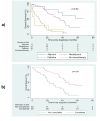Real-world breast cancer treatment patterns and guideline-concordant treatment completion among Malawian women
- PMID: 40158080
- PMCID: PMC11954205
- DOI: 10.1186/s12905-025-03667-6
Real-world breast cancer treatment patterns and guideline-concordant treatment completion among Malawian women
Abstract
Purpose: In Sub-Saharan Africa (SSA), resource-stratified guidelines for breast cancer treatment are increasingly recommended, but treatment receipt and outcomes according to these guidelines are underreported. Here, we describe breast cancer treatment patterns by stage and curative-intent guideline-concordant treatment (GCT) receipt among Malawian women.
Methods: A prospective cohort of breast cancer patients were enrolled from December 2016 to October 2018 at Kamuzu Central Hospital with an assessment of demographics, stage, and treatment received, including neoadjuvant (NAC), adjuvant (AdC) and palliative chemotherapy and breast surgery. Curative-intent GCT was defined as having completed breast surgery and at least 4 cycles of chemotherapy. Overall survival (OS) was calculated using Kaplan Meier methods and odds ratios using logistic regression.
Results: 91 patients were included, of whom 13 (14%) presented as stage II, 54 (59%) as stage III, and 24 (26%) as stage IV. Curative treatment was recommended for 65 of 91 (71%) patients, of whom 47 (72%) were initiated on NAC, 14 (22%) on upfront breast surgery, and 4 (6%) received no treatment. Only 63% (41/65) of patients received curative-intent GCT as recommended with non-GCT associated with stage III (vs. stage II) disease (OR 0.10 CI (0.01-0.89)), HIV positivity ((OR 0.25 CI (0.06-0.99)) and hormone receptor (HR) negative/HER2 positive subtype ((OR 0.07 CI (0.01-0.49)). Curative-intent GCT was associated with improved OS (44.1 vs. 23.2 months; p = 0.00) compared to non-GCT.
Conclusion: While curative-intent GCT was associated with improved survival in this Malawian cohort, treatment completion rates were suboptimal. Resource-stratified guidelines must be paired with locally relevant, multilevel implementation strategies to target barriers to treatment completion.
Keywords: Breast cancer; Malawi; Treatment.
© 2025. The Author(s).
Conflict of interest statement
Declarations. Ethics approval and consent to participate: This study was approved by the Institutional Review Board at UNC and the Malawi National Health Science Research Committee in compliance with the Declaration of Helsinki. All patients provided written informed consent at the time of enrollment. Consent for publication: Not applicable. Competing interests: The authors declare no competing interests.
Figures


References
-
- Sung H, Ferlay J, Siegel RL, et al. Global cancer statistics 2020: GLOBOCAN estimates of incidence and mortality worldwide for 36 cancers in 185 countries. CA Cancer J Clin. 2021;71(3):209–49. - PubMed
-
- American Cancer Society. Cancer Facts and Fig. (2020). https://www.cancer.org/cancer/breast-cancer/understanding-a-breast-cance... Accessed 10 May 2023.
-
- Carlson RW, Scavone JL, Koh WJ, et al. NCCN framework for resource stratification: A framework for providing and improving global quality oncology care. J Natl Compr Canc Netw. 2016;14(8):961–9. - PubMed
-
- National Comprehensive Cancer Network (NCCN) Harmonized Guidelines™ for Sub-Saharan Africa: Breast Cancer: Version 4.2021. (2021) https://www.nccn.org/professionals/physician_gls /pdf/breast_harmonized-africa.pdf. Accessed 2 February 2024.
MeSH terms
Grants and funding
LinkOut - more resources
Full Text Sources
Medical
Research Materials
Miscellaneous

